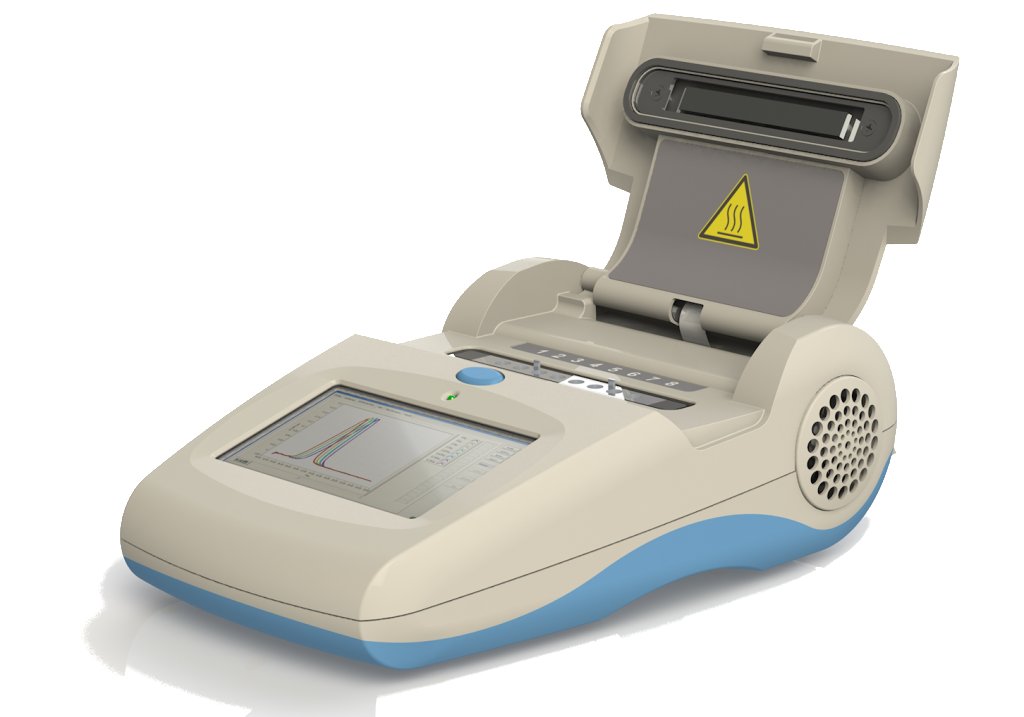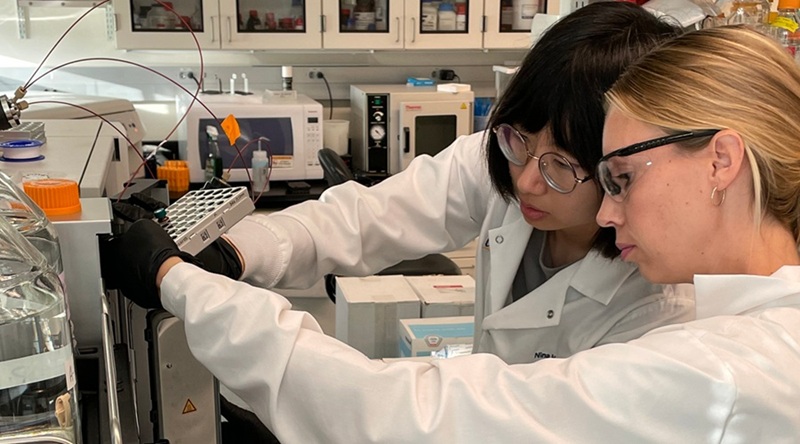Loop-Mediated Isothermal Amplification-Assay Rapidly Diagnoses COVID-19
|
By LabMedica International staff writers Posted on 25 Aug 2020 |

Image: The Genie III instrument was used for the reverse transcriptase loop-mediated isothermal amplification-assay called N1 gene Single Tube Optigene LAMP (N1-STOP-LAMP) for COVID-19 (Photo courtesy of OptiGene Ltd).
The SARS-CoV-2 (COVID-19) pandemic of 2020 has resulted in unparalleled requirements for RNA extraction kits and enzymes required for virus detection, leading to global shortages. This has necessitated the exploration of alternative diagnostic options to alleviate supply chain issues.
The loop-mediated isothermal amplification (LAMP) assay is robust, rapid and straightforward, yet retains high sensitivity. These features have seen the LAMP assay and the inclusion of a reverse transcriptase (RT-LAMP) implemented for a broad range of molecular diagnostic applications extending from infectious diseases, virus, bacteria and parasites, to cancer.
Microbiologists at the University of Melbourne (Melbourne, Australia) and their associates collected 157 confirmed-positive nasopharyngeal swabs between the March 23 and April 4 2020. The team developed a rapid molecular test called N1 gene Single Tube Optigene LAMP (N1-STOP-LAMP), a reverse transcriptase loop-mediated isothermal amplification-assay. Copan flocked swabs were collected and directly inoculated on site in either 1 mL or 3 mL of universal transport medium (UTM, Copan Diagnostics, Murrieta, CA, USA).
A 200 µL aliquot of Copan UTM was processed through the QIAsymphony DSP Virus/Pathogen Mini Kit (Qiagen, Hilden, Germany) on the QIAsymphony SP instrument. Each N1-STOP-LAMP reactions were assembled in either 8-tube Genie strips (OptiGene Ltd, Horsham, UK) or 96-MicroAmp-Fast-Optical reaction plate (Applied Biosystems, Foster City, CA, USA). Strip tubes were loaded onto the OptiGene Genie-II or Genie-III and 96-well plates run on an Applied Biosystems’ QuantStudio 7 thermocycler.
The scientists reported that the assay evaluation by assessment of 157 clinical specimens previously screened by E-gene RT-qPCR revealed the N1-STOP-LAMP assay had sensitivity and specificity of 87% and 100%, respectively. Results were fast, with an average time-to-positive (Tp) for 93 clinical samples of 14 ± 7 minutes. The team also evaluated assay performance against FDA guidelines for implementation of emergency-use diagnostics and established a limit-of-detection of 54 Tissue Culture Infectious Dose 50 per mL (TCID50 mL−1), with satisfactory assay sensitivity and specificity. A comparison of 20 clinical specimens between four laboratories showed excellent inter-laboratory concordance; performing equally well on three different, commonly used thermocyclers, pointing to the robustness of the assay.
The authors concluded that with a simplified workflow, The N1 gene Single Tube Optigene LAMP assay is a powerful, scalable option for specific and rapid detection of SARS-CoV-2 and an additional resource in the diagnostic armamentarium against COVID-19. The study was published on August 5, 2020 in the Journal of Medical Microbiology.
Related Links:
University of Melbourne
Copan Diagnostics
Qiagen
OptiGene Ltd
Applied Biosystems
The loop-mediated isothermal amplification (LAMP) assay is robust, rapid and straightforward, yet retains high sensitivity. These features have seen the LAMP assay and the inclusion of a reverse transcriptase (RT-LAMP) implemented for a broad range of molecular diagnostic applications extending from infectious diseases, virus, bacteria and parasites, to cancer.
Microbiologists at the University of Melbourne (Melbourne, Australia) and their associates collected 157 confirmed-positive nasopharyngeal swabs between the March 23 and April 4 2020. The team developed a rapid molecular test called N1 gene Single Tube Optigene LAMP (N1-STOP-LAMP), a reverse transcriptase loop-mediated isothermal amplification-assay. Copan flocked swabs were collected and directly inoculated on site in either 1 mL or 3 mL of universal transport medium (UTM, Copan Diagnostics, Murrieta, CA, USA).
A 200 µL aliquot of Copan UTM was processed through the QIAsymphony DSP Virus/Pathogen Mini Kit (Qiagen, Hilden, Germany) on the QIAsymphony SP instrument. Each N1-STOP-LAMP reactions were assembled in either 8-tube Genie strips (OptiGene Ltd, Horsham, UK) or 96-MicroAmp-Fast-Optical reaction plate (Applied Biosystems, Foster City, CA, USA). Strip tubes were loaded onto the OptiGene Genie-II or Genie-III and 96-well plates run on an Applied Biosystems’ QuantStudio 7 thermocycler.
The scientists reported that the assay evaluation by assessment of 157 clinical specimens previously screened by E-gene RT-qPCR revealed the N1-STOP-LAMP assay had sensitivity and specificity of 87% and 100%, respectively. Results were fast, with an average time-to-positive (Tp) for 93 clinical samples of 14 ± 7 minutes. The team also evaluated assay performance against FDA guidelines for implementation of emergency-use diagnostics and established a limit-of-detection of 54 Tissue Culture Infectious Dose 50 per mL (TCID50 mL−1), with satisfactory assay sensitivity and specificity. A comparison of 20 clinical specimens between four laboratories showed excellent inter-laboratory concordance; performing equally well on three different, commonly used thermocyclers, pointing to the robustness of the assay.
The authors concluded that with a simplified workflow, The N1 gene Single Tube Optigene LAMP assay is a powerful, scalable option for specific and rapid detection of SARS-CoV-2 and an additional resource in the diagnostic armamentarium against COVID-19. The study was published on August 5, 2020 in the Journal of Medical Microbiology.
Related Links:
University of Melbourne
Copan Diagnostics
Qiagen
OptiGene Ltd
Applied Biosystems
Latest Molecular Diagnostics News
- Ultrasensitive Method Detects Low-Frequency Cancer Mutations
- Blood Test Enables Non-Invasive Endometriosis Detection
- New Blood Biomarkers Help Diagnose Pregnancy-Linked Liver Complication
- Simple Urine Test to Revolutionize Bladder Cancer Diagnosis and Treatment
- Blood Test to Enable Earlier and Simpler Detection of Liver Fibrosis
- Genetic Marker to Help Children with T-Cell Leukemia Avoid Unnecessary Chemotherapy
- Four-Gene Blood Test Rules Out Bacterial Lung Infection
- New PCR Test Improves Diagnostic Accuracy of Bacterial Vaginosis and Candida Vaginitis
- New Serum Marker-Editing Strategy to Improve Diagnosis of Neurological Diseases
- World’s First Genetic Type 1 Diabetes Risk Test Enables Early Detection
- Blood Test to Help Low-Risk Gastric Cancer Patients Avoid Unnecessary Surgery
- First-Of-Its-Kind Automated System Speeds Myeloma Diagnosis
- Blood Protein Profiles Predict Mortality Risk for Earlier Medical Intervention
- First Of Its Kind Blood Test Detects Gastric Cancer in Asymptomatic Patients
- Portable Molecular Test Detects STIs at POC in 15 Minutes
- Benchtop Analyzer Runs Chemistries, Immunoassays and Hematology in Single Device
Channels
Clinical Chemistry
view channel
Online Tool Detects Drug Exposure Directly from Patient Samples
Doctors often rely on patient interviews and medical records to determine what medications a person has taken, but this information is frequently incomplete. People may forget drugs they used, take over-the-counter... Read more
Chemical Imaging Probe Could Track and Treat Prostate Cancer
Prostate cancer remains a leading cause of illness and death among men, with many patients eventually developing resistance to standard hormone-blocking therapies. These drugs often lose effectiveness... Read moreMolecular Diagnostics
view channel
Ultrasensitive Method Detects Low-Frequency Cancer Mutations
Liquid biopsy has emerged as a promising approach for cancer detection and treatment monitoring, although its clinical impact has been limited by the extremely low levels of tumor-derived DNA circulating in blood.... Read more
Blood Test Enables Non-Invasive Endometriosis Detection
Endometriosis is a chronic, complex, yet relatively common gynecological disorder, reportedly affecting 1 in 10 adult and adolescent women. Endometriosis causes tissue similar to the lining of the uterus... Read moreHematology
view channel
MRD Tests Could Predict Survival in Leukemia Patients
Acute myeloid leukemia is an aggressive blood cancer that disrupts normal blood cell production and often relapses even after intensive treatment. Clinicians currently lack early, reliable markers to predict... Read more
Platelet Activity Blood Test in Middle Age Could Identify Early Alzheimer’s Risk
Early detection of Alzheimer’s disease remains one of the biggest unmet needs in neurology, particularly because the biological changes underlying the disorder begin decades before memory symptoms appear.... Read more
Microvesicles Measurement Could Detect Vascular Injury in Sickle Cell Disease Patients
Assessing disease severity in sickle cell disease (SCD) remains challenging, especially when trying to predict hemolysis, vascular injury, and risk of complications such as vaso-occlusive crises.... Read more
ADLM’s New Coagulation Testing Guidance to Improve Care for Patients on Blood Thinners
Direct oral anticoagulants (DOACs) are one of the most common types of blood thinners. Patients take them to prevent a host of complications that could arise from blood clotting, including stroke, deep... Read moreImmunology
view channel
Routine Blood Test Can Predict Who Benefits Most from CAR T-Cell Therapy
CAR T-cell therapy has transformed treatment for patients with relapsed or treatment-resistant non-Hodgkin lymphoma, but many patients eventually relapse despite an initial response. Clinicians currently... Read more
New Test Distinguishes Vaccine-Induced False Positives from Active HIV Infection
Since HIV was identified in 1983, more than 91 million people have contracted the virus, and over 44 million have died from related causes. Today, nearly 40 million individuals worldwide live with HIV-1,... Read more
Gene Signature Test Predicts Response to Key Breast Cancer Treatment
DK4/6 inhibitors paired with hormone therapy have become a cornerstone treatment for advanced HR+/HER2– breast cancer, slowing tumor growth by blocking key proteins that drive cell division.... Read more
Chip Captures Cancer Cells from Blood to Help Select Right Breast Cancer Treatment
Ductal carcinoma in situ (DCIS) accounts for about a quarter of all breast cancer cases and generally carries a good prognosis. This non-invasive form of the disease may or may not become life-threatening.... Read morePathology
view channel
Rapid Low-Cost Tests Can Prevent Child Deaths from Contaminated Medicinal Syrups
Medicinal syrups contaminated with toxic chemicals have caused the deaths of hundreds of children worldwide, exposing a critical gap in how these products are tested before reaching patients.... Read more
Tumor Signals in Saliva and Blood Enable Non-Invasive Monitoring of Head and Neck Cancer
Head and neck cancers are among the most aggressive malignancies worldwide, with nearly 900,000 new cases diagnosed each year. Monitoring these cancers for recurrence or relapse typically relies on tissue... Read more
Common Health Issues Can Influence New Blood Tests for Alzheimer’s Disease
Blood-based tests for Alzheimer’s disease are transforming diagnosis by offering a simpler alternative to spinal taps and brain imaging. However, many people evaluated at memory clinics also live with... Read more
Blood Test Formula Identifies Chronic Liver Disease Patients with Higher Cancer Risk
Chronic liver disease affects millions worldwide and can progress silently to hepatocellular carcinoma (HCC), one of the deadliest cancers globally. While surveillance guidelines exist for patients with... Read moreTechnology
view channel
Machine Learning Models Diagnose ALS Earlier Through Blood Biomarkers
Amyotrophic lateral sclerosis (ALS) is a rapidly progressive neurodegenerative disease that is notoriously difficult to diagnose in its early stages. Early symptoms often overlap with other neurological... Read more
Artificial Intelligence Model Could Accelerate Rare Disease Diagnosis
Identifying which genetic variants actually cause disease remains one of the biggest challenges in genomic medicine. Each person carries tens of thousands of DNA changes, yet only a few meaningfully alter... Read moreIndustry
view channel
Abbott Acquires Cancer-Screening Company Exact Sciences
Abbott (Abbott Park, IL, USA) has entered into a definitive agreement to acquire Exact Sciences (Madison, WI, USA), enabling it to enter and lead in fast-growing cancer diagnostics segments.... Read more



















